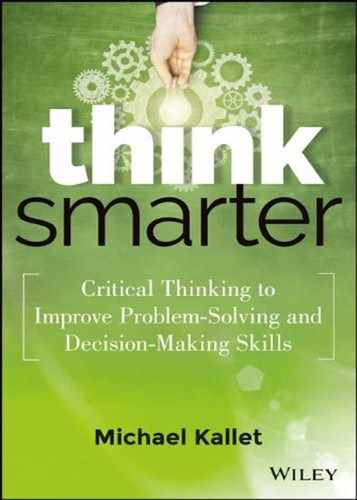32 Criteria
Without Criteria, Nothing Is Decided
Criteria are conditions that, if met, lead to a decision of yea—and if not met, the decision is nay or deferred to a later time. Suppose you concluded to buy a television because your existing one no longer works and needs to be replaced. Your family need is that everyone in your household likes to watch television—at least occasionally—so you consider this item essential to family entertainment. Your personal need is that your family will drive you crazy if you don't replace the television.
Let's say you are the decision maker in this scenario, and you've set a date to replace the television within three days from now. Off you go to the store. Do you buy just any television? Price probably comes into play, and perhaps financing. Other criteria might be size, picture quality, and perhaps number of plug-ins and other features, such as USB, HDMI, RGB, wireless, Internet readiness, and an internal alarm clock. You have your features checklist, and if you find a television meeting those criteria, then you'll buy it. If you walk into the store without criteria, you'll spend far longer evaluating televisions. You may not consciously make a list, but eventually, you will have criteria for purchasing. If you do a little critical thinking and understand the purchase criteria, you'll decide much more quickly.
Although it's not frequently written down anywhere, decision makers in business use the same process. Let's say you were asked to streamline a process to reduce manufacturing costs. After getting clear on the issues, you conclude to eliminate and combine some steps, shuffle some responsibilities, and implement a training program. The cost could be $20,000, with the payback projected to be about two years. You have a conversation with your manager and create a decision criteria checklist:
- Costs less than $25,000: yes/no
- Payback less than three years: yes/no
- Training program identified: yes/no
- Cost reduction greater than 20 percent: yes/no
- Night shift manager agrees with change: yes/no
You review your conclusions and the criteria, and you say, “Yes, Yes, Yes, Yes, Yes.” Your manager says, “Go.” Of course, if you had responded “No” to any of these criteria, your manager also would have said, “No,” or “You'll need to meet these criteria before I can say yes.” At that point, you would've had to go back and adjust your plan.
It's best to set the criteria for a decision as far ahead of the conversations for approval as possible. This way, you don't first learn about a criterion while you're seeking approval. You avoid going back to determine whether you meet the new criterion, then returning for approval and presenting your case again.
What happens if you can't have a criteria conversation? There are some situations where this is the case; say, for example, that your boss's boss's boss will decide. He travels often, and you're just never going to have that conversation. You then have to ask yourself: What criteria would you use if it were your decision? The closer you get to the decision maker's criteria, the less interaction you'll need with him, and the faster the decision will come.
Getting Started with Criteria
Here are some things to remember about using criteria:
- Identify the decision maker as soon as you reach a conclusion: Start by asking yourself what you think the criteria should be. If you have access to the decision maker, ask what criteria, if met, will get a yea.
- Take the first stab at criteria: Don't approach your manager with a blank page and ask him or her to list the criteria for a decision. He or she is likely to say, “When it makes business sense”—which doesn't help very much. Instead, start your criteria list, and ask your manager if it looks right or if there are other criteria you should add. Doing so is more efficient and generates a more in-depth response.
- List criteria that matter: Although some features are nice to have, criteria should be those items when if met produce a go, and if not met produce a no-go. If you're buying a new phone, and it really doesn't matter if it's black or white, then don't put that down as a criterion. If the screen size matters, then make it a criterion.
The Takeaway
Decisions require a checklist, a list of criteria with which to decide. If the conditions are met, you act. Without conscious criteria, you make no decision—or a bad decision.
Exercises for Criteria
- Go back to your to-do list. Those items remain there because you either don't have the need to do them or haven't figured out criteria for accomplishing them. What satisfied criteria will initiate action?
- It's Friday afternoon, and you conclude to visit a close relative tomorrow. It's a three-hour drive. The 11:00 PM news calls for bad weather. What criteria would you use Saturday morning to decide whether to visit your relative?
- A customer asked to return a new microwave oven she purchased because it no longer worked. Your warranty is 90 days, yet she purchased the oven 110 days ago. She explained she was out of the country for a month. You concluded she can bring in the microwave oven, and you'll replace it. She arrives with her microwave. What conditions (criteria) will you use to decide whether to replace the oven?
